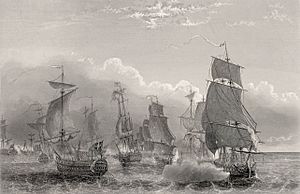Battle of Martinique (1779) facts for kids
Quick facts for kids Battle of Martinique |
|||||||
|---|---|---|---|---|---|---|---|
| Part of the American Revolutionary War | |||||||
 Bataille de la Martinique, Jean-Marie Chavane |
|||||||
|
|||||||
| Belligerents | |||||||
| Commanders and leaders | |||||||
| Strength | |||||||
| 13 ships of the line | 3 ships of the line 26 merchant ships |
||||||
| Casualties and losses | |||||||
| 150 killed and wounded 2 ships of the line damaged |
9 merchant ships captured 4 merchant ships destroyed |
||||||
The Battle of Martinique was a sea fight that happened on December 18, 1779. It took place near the island of Martinique in the West Indies. This battle was part of the larger American Revolutionary War.
It was a clash between a British fleet of 13 warships, led by Admiral Hyde Parker, and a smaller French group of three warships. The French ships were commanded by Admiral Lamotte-Picquet.
The French admiral bravely used his small force to protect a group of French supply ships. These supply ships were being chased by the British. For about 90 minutes, Lamotte-Picquet's lead ship, the Annibal, fought the much larger British fleet alone. This allowed the other French ships to join and help the convoy escape. Even though some supply ships were captured, many got away. Admiral Hyde Parker was so impressed that he later sent a letter praising Lamotte-Picquet's skill.
Contents
Why Did the Battle of Martinique Happen?
In late 1779, a British fleet was resting at St. Lucia. The British had captured this island the year before. Admiral Hyde Parker was waiting for another admiral to arrive and lead new attacks. His ships were being repaired, and many sailors were on land.
Meanwhile, the French navy in the Caribbean was fixing its ships at nearby Martinique. The French commander was Lamotte-Picquet. His group had eight warships, but only three were ready for battle in December 1779. These were the Annibal (a large 74-gun ship) and two 64-gun ships, the Vengeur and the Réfléchi.
How the Battle Unfolded
On the morning of December 18, 1779, a French convoy arrived near Martinique. A convoy is a group of ships traveling together, usually with protection. These 26 supply ships were coming from France. They carried important supplies for the French colonies and for Lamotte-Picquet's fleet. They were protected by only one frigate, the Aurore.
Around 8:00 AM, a British ship spotted the French convoy. Admiral Parker quickly got five of his large warships and a smaller 50-gun frigate ready. He sent them out to meet the arriving French ships. Soon, the French on Martinique also saw the convoy and 15 British warships chasing them.
The French convoy tried to sail very close to the shore. They hoped the shallow water would stop the big British warships. The Aurore frigate stayed behind to fight the British. This was a brave move to delay the British and warn the French forces on Martinique.
Lamotte-Picquet quickly gathered his ships to protect the convoy. He even got volunteers from the island to help man his ships. He left the port with his flagship, the Annibal. Because of the wind, he could position his ship to cover the arriving convoy.
The British fleet, led by the Conqueror, slowly moved towards the French. By 5:00 PM, the Conqueror was close enough to fire at the Annibal. The Annibal found itself fighting seven British ships alone for about 30 minutes. Then, the other two French ships, the Vengeur and the Réfléchi, joined the fight. The French crews fought very hard, firing their cannons quickly. The Annibal even turned to fire from both sides at once!
As evening came, another British ship joined the battle. But the fighting was getting very close to the shallow waters near the French port. Cannons from the French forts on shore also began firing at the British ships. Admiral Parker finally called off his fleet at 6:45 PM. However, a final shot from the French fleet killed the captain of the Conqueror.
What Happened After the Battle?
The French convoy suffered losses. Thirteen of their supply ships were either captured by the British or had to be run aground to avoid capture. However, Admiral Parker was impressed with the French. He was also pleased with his own fleet's actions and the ships they captured.
Admiral Hyde Parker was so impressed by Lamotte-Picquet's actions that he sent him a special letter. It said:
The conduct of your Excellency in the affair of the 18th of this month fully justifies the reputation which you enjoy among us, and I assure you that I could not witness without envy the skill you showed on that occasion. Our enmity is transient, depending upon our masters; but your merit has stamped upon my heart the greatest admiration for yourself.
This means Parker admired Lamotte-Picquet's skill, even though they were enemies.
Lamotte-Picquet was honored for his bravery. He was made a Commander in the Order of Saint Louis, a special award. The French government even ordered a painting to celebrate this battle. This painting is now on display in a museum.
Images for kids







